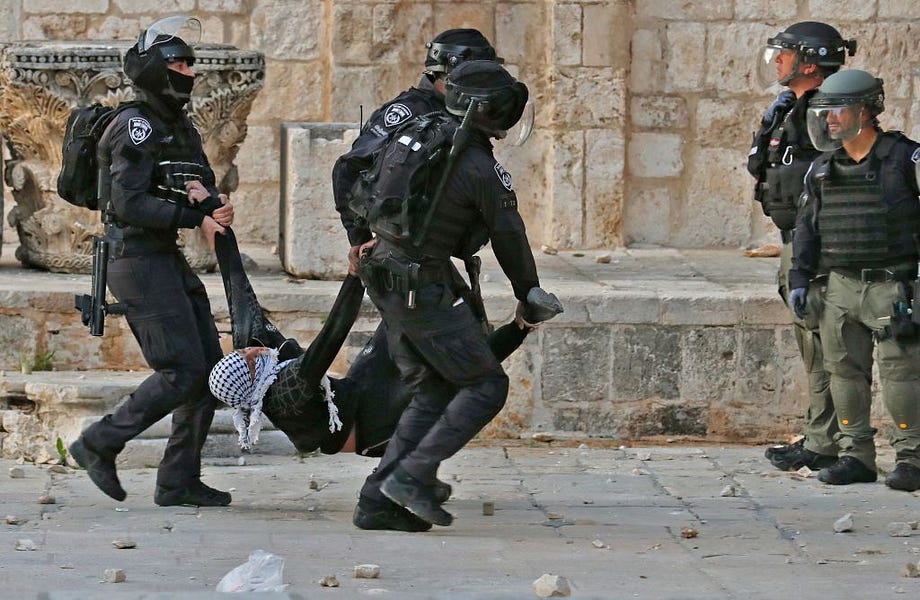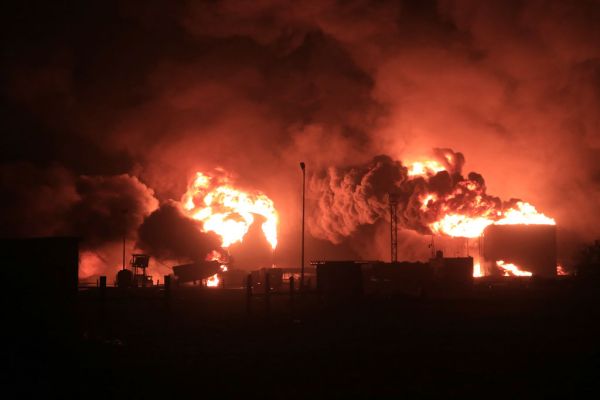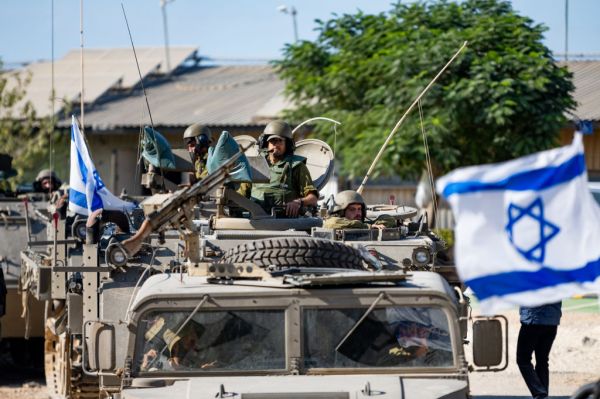The residents of Sderot, Israel, are no strangers to conflict. The border city of roughly 25,000 has sustained thousands of incoming projectiles from nearby Gaza Strip—thwarted by the Iron Dome’s short-range interceptors with varying degrees of success—since Israeli forces withdrew from the nearby territory more than 16 years ago.
But frequency and preparation don’t make rocket attacks like the one that struck near a Sderot home last Wednesday any easier for the city’s occupants, particularly children growing up in the crossfire.
“People think that, OK, they shot one rocket, who cares? But you have to understand the post-trauma,” Ari Katz, who works at a local yeshiva, told The Dispatch. “For the kids especially, that one rocket makes their world go upside down again. It’s hard to convey what, emotionally, the kids and people in Sderot go through.”
During Israel’s 11-day war with Gaza-based militants last year, Katz explained, the typically lively Sderot community effectively shut down amid “constant” explosions and warning sirens. And it wasn’t alone. Last May, local brawls in cities with mixed ethnic and religious populations, including Jerusalem, quickly escalated into a cross-border fight between Israel and Hamas-led Gaza. In less than two weeks, the combination of combat and civil unrest resulted in more than 260 military and civilian deaths on both sides and at least 72,000 more displacements.
As the deadly conflict nears its one year anniversary next month, many fear a repeat performance, especially with violence mounting again. But Hamas and other groups may not have the arsenal to sustain another barrage, despite help from regional bad actors such as Iran.
On Temple Mount—home to both Jewish and Muslim holy sites—violent clashes between Palestinian demonstrators and Israeli police have broken out once again. And after a period of relative lull since the end of last year’s war, terrorist groups in Gaza launched six rockets toward Israeli civilian areas last week. Lebanon-based militants also signaled their involvement on Monday, firing a rocket that landed near a kibbutz in northern Israel. It’s likely, though unconfirmed, that the projectile was the work of the same Palestinian factions responsible for a series of attacks emanating from Lebanese soil during last year’s war.
“After the war of last year, it was revealed that there is some kind of operation center that is based in Beirut that is operated by Hamas, Hezbollah, and Iran,” Jonathan Schanzer, senior vice president of the Foundation for Defense of Democracies (FDD) and author of Gaza Conflict 2021, told The Dispatch. “They appear to be testing Israeli responses.”
In retaliation for Monday’s attack, Israeli forces targeted a firing range in southern Lebanon with artillery shelling. In response to last week’s attacks from Gaza, the Israeli Air Force conducted airstrikes on Hamas military infrastructure.
The uptick in violence has coincided with the Muslim holiday of Ramadan, which Hamas promised would mark a period of “jihad, martyrdom, and mighty victories” at the month’s start. “We strengthen the hands of our heroes who are rising up in all the cities and refugee camps, first and foremost Jerusalem, and stress [that there will be] continued resistance to the occupation and to its settlers, by all possible means, until liberation and return,” the announcement added.
The messaging seems to have resonated. Earlier this month, men wearing full face coverings and waving Hamas and Palestinian Authority flags entered al-Aqsa Mosque around 4 a.m. to throw stones, set off fireworks, and barricade themselves inside. The Muslim place of worship sits atop the Temple Mount, Judaism’s holiest site. For six hours, Israeli police—who typically refrain from entering the mosque in large numbers—struggled to put down the riot, arresting 470 demonstrators before noon. More than 150 Palestinians were wounded in the skirmish, according to the Palestinian Red Crescent.
Violent confrontations in and around the compound have continued since. On April 17 (Easter Sunday for Protestants and Catholics), fighting erupted after Israeli officials entered the complex as hundreds of protesters gathered rocks and prepared makeshift barricades. The same morning, young Palestinians lobbed rocks at buses of visitors on their way to the Western Wall, injuring several. Last Friday, Israeli police reportedly contained a Hamas rally using tear gas and sponge bullets, wounding at least 57 Palestinians.
“The current escalating tensions in Israel are best seen as part of a broader cycle of violence that escalates most often around the religious holidays, and has been exacerbated by the convergence of Passover, Ramadan, and Easter all happening at the same time this year,” Carmiel Arbit, a senior fellow for Middle East programs at the Atlantic Council, told The Dispatch. “One thing is clear: Unless Israelis and Palestinians meaningfully address the grievances underlying the fighting, the cycle of quiet and conflict will continue for years to come—with tragic results for all sides.”
But Hamas and other militias have already upped their bellicose rhetoric.
Earlier this month, Hamas official Ismail Haniyeh said Palestinians face two options: “To accept the occupation assault, its brutality, and its colonial settlers’ animal slaughter in al-Aqsa Mosque,” or “to consolidate the Islamic character and origin of Jerusalem and the al-Aqsa Mosque.” The veiled threat referred to alleged attempts by some Jewish extremist groups to sacrifice a goat in the complex for Passover. And a politician with the Palestinian Islamic Jihad (PIJ)—another terrorist faction out of Gaza—condemned the “the repeated and escalating Zionist attacks on al-Aqsa Mosque,” falsely claiming that Jews planned to demolish the site.
The extremist groups’ Iranian backers have also inflamed the growing tensions. In a recent call with PIJ leader Ziyad al-Nakhalah, Iranian Supreme Leader Ali Khamenei’s advisor reportedly “expressed his confidence” that the “jihad of the Palestinian people will produce a great victory.”
The supreme leader himself chimed in a rare recorded speech praising Palestinian rioters in Jerusalem: “Palestine is alive despite the policies of the U.S. and the policies of its followers, who wished to consign the issue of Palestine to oblivion so that it would be forgotten. … Today, the Palestinian youth in the 1948 lands, not in some remote lands, rather in the center of occupied Palestine, have woken up. They are moving, striving, and working, and this will continue.”
“Iran plays a role here as well—political, financial, and logistical,” Jason Brodsky, policy director of United Against a Nuclear Iran, told The Dispatch. “This pours gasoline on the fire.”
Iranian military and financial support has proven crucial for Hamas, particularly as it restocks its reduced rocket arsenal following more than 4,300 rocket launches during last year’s war. But the Gazan groups may still remain ill-equipped to conduct an operation on par with the previous conflict. In addition to expending many of Hamas’ more advanced and long-range rockets, the brief war also saw the destruction of its extensive labyrinth of tunnels from which the group planned to kill and kidnap Israeli soldiers.
“Having taken a fairly significant beating during the war of last year, they’re not in a position of strength. They don’t have the tunnel system, they’ve got a depleted rocket store. So they’ve got less of an incentive to engage in a full-on conflict, unless they were somehow able to replenish more quickly or to acquire new or more advanced systems,” said Schanzer, senior vice president of FDD. “Overall, Hamas is probably trying to rebuild and to think about its next strategies.”
Whether Hamas will determine that another confrontation is in its best interests remains unclear as Ramadan draws to a close, but Israelis and Palestinians alike—particularly those in conflict-prone areas—are hoping for de-escalation.
“Hamas calls the shots. Whenever Hamas feels it’s worth it for them to start escalating, they’ll escalate,” said Katz, the Sderot-based yeshiva worker. “I believe that the majority of the Palestinians, of the Arabs living in the Gaza Strip want peace … Why should the civilians suffer because of Hamas’ actions?”









Please note that we at The Dispatch hold ourselves, our work, and our commenters to a higher standard than other places on the internet. We welcome comments that foster genuine debate or discussion—including comments critical of us or our work—but responses that include ad hominem attacks on fellow Dispatch members or are intended to stoke fear and anger may be moderated.